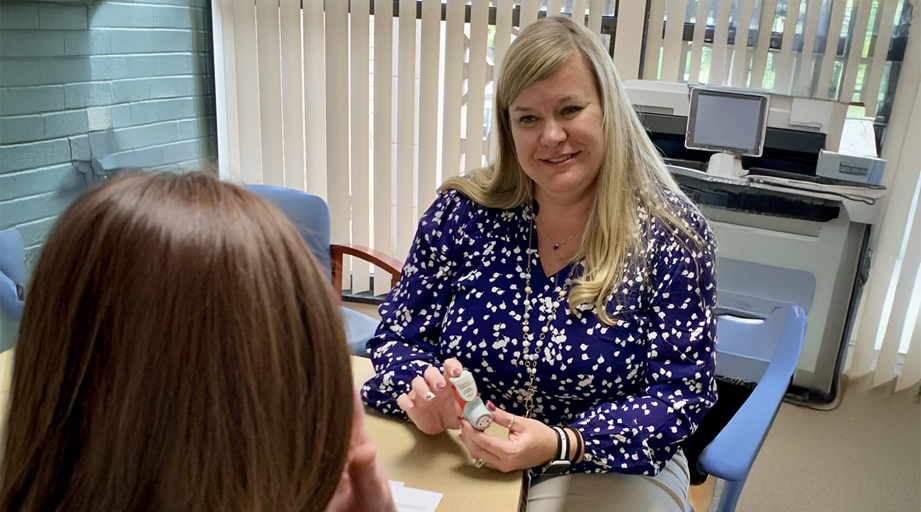
Christi Jen could finally relax. The ASHP member was on a red-eye flight home from last month's Summer Meetings & Exhibition in Baltimore, Maryland, where the House of Delegates (HOD) had approved a policy she recommended to improve the quality and contents of emergency medical kits. But not long after she dozed off, the flight attendants requested medical help — a passenger was having trouble breathing.
Jen, a clinical pharmacy manager for the Mayo Clinic in Arizona, asked for the flight’s emergency medical kit to check the woman’s blood pressure and heart rate. But neither she nor a retired nurse could get the kit’s stethoscope and manual blood pressure cuff to work properly. Jen ended up taking the passenger’s vitals on her own Apple watch.
“I was like, ‘What is the universe trying to tell me?’” said Jen, who is also co-writing a journal article on problems with the kits and had even tucked her research into the backseat pocket in front of her just before she responded to the call for help.
Not every ASHP member has seen the potential impact of the HOD’s newest policies illustrated quite as vividly as Jen did — at least not on their way home from Summer Meetings. But the policies approved at this year’s session do aim to help shape healthcare and the pharmacy workforce for years to come. Here are a few.
Emergency Medical Kits
After a social media campaign last year highlighted a lack of standardization in emergency medical kits on airplanes, Jen teamed up with fellow ASHP members Megan Musselman and Stephanie Weightman to put forth a proposed policy aimed at improving the contents and storage of medications in the kits. The approved policy advocates for ASHP to collaborate with other professional organizations to standardize the contents of the kits and help develop guidelines and training for proper use.
Jen said ASHP and other healthcare organizations should work with the Federal Aviation Administration to improve the quality and contents of the emergency kits. “We have this knowledge,” she said. And, as she learned on her way home from the House session, “We may be called on to respond.”
Removal of Injectable Promethazine from Hospital Formularies
Perhaps the proposal that generated the most debate at this year’s HOD session, this policy is in line with the Institute for Safe Medication Practices’ call for eliminating injectable promethazine — which can cause tissue damage and necrosis — from hospital formularies.
“It was expected it’d be one of the more controversial policies,” said Kelly Bobo, who served as the 2022-2023 chair of the Council on Therapeutics. “Promethazine is an older medication, it’s been around a long time, but there are safety concerns with its administration.”
Bobo, a clinical pharmacy manager at Le Bonheur Children’s Hospital in Memphis, Tennessee, noted that some hospitals have continued to use the medication, putting in place safety measures around its administration. However, there have not been studies surrounding the effectiveness of such measures.
The medication can be used to prevent nausea and vomiting for different conditions. “There’s a very strong push in pediatric oncology that there’s still a niche for this therapy. There are still patients who don’t respond to other things,” Bobo said. “Where it gets tricky is that there are a lot of hospitals, including pediatric hospitals, that have successfully removed this medication from formulary and are still able to take excellent care of their patients.”
Bobo said she hopes the policy will encourage hospitals that have removed promethazine from their formularies to share their experiences and advice.
Point-of-Care Testing and Treatment by Pharmacists
This policy advocates for laws and regulations that allow pharmacists to perform diagnostic point-of-care testing. Monica Dziuba, an ASHP member who helped spearhead the policy’s passage, said the policy is a natural extension of the work that pharmacists did to oversee the COVID-19 vaccination rollout. “I saw firsthand what we could do,” she said.
Point-of-care testing could help make care more efficient by giving patients one stop for testing and treatment. And it would allow pharmacists to provide preventative medications and care for acute conditions based on the test results. “Implementing policies like point-of-care testing allows us to streamline access,” said Dziuba, a pharmacy manager at UVA Health.
Dziuba said that following the HOD debate, the policy was amended to make clear that pharmacists were not asking to make a diagnosis. “We are taking the test result and can make a clinical decision about what’s best for the patient. It came together really nicely, to increase our scope of practice by advocating for us to have access to these test results and generating prescriptions and administering a vaccine or medication to the patient,” she said.
Next step, she said, will be to push for the changes at the state level. “We all know that we’re here for the patients,” she said. “So if there’s a legislative barrier to that, then ASHP can give us the tools to change it.”
Pharmacist Prescribing Authority for Antiretroviral Therapy for HIV/AIDS Prevention
This policy advocates for legislation and regulations that expand pharmacist scope of practice to include initiation of pre-exposure prophylaxis (PrEP) and post-exposure prophylaxis (PEP) for HIV infection prevention. The policy also supports zero cost-sharing for patients.
“I feel like everybody was supportive,” said Bobo. “It’s truly a public health initiative. What this policy is really trying to encourage is that pharmacists be allowed a greater role in being able to give these therapies as part of their scope of practice versus just being something we fill as the prescription comes across,” said Bobo. She noted that many patients, particularly in rural areas, have greater access to their local pharmacists than to other providers.
“And because we have a lot of access to patients, there are a lot of ways we can help,” she said. “A lot of our health-system pharmacists work in ambulatory care clinics and can see those patients.”
Support for Fentanyl Test Strips
The HOD approved a policy that says fentanyl test strips should be included in harm reduction strategies for people who use drugs. The policy supports legislation declassifying fentanyl test strips as drug paraphernalia and promotes public access to the strips, including zero-cost options.
Martha Roberts, a Rhode Island delegate, got interested in the issue as she continued to hear about alarming rates of overdoses exacerbated by illicit fentanyl found in other drugs. Most concerning, she said, are those states that classify the strips as drug paraphernalia. Healthcare providers should get behind something that could help prevent overdoses, she said. The strips can detect whether fentanyl is involved in an overdose to help guide naloxone use.
“I think that’s a key takeaway: How does your state classify it?” she said, suggesting members consider advocating with their state legislatures. “I think there are a lot of avenues for ASHP to help decrease these unnecessary deaths.”
Over-the-Counter (OTC) Availability of Hormonal Contraceptives
The policy, which came a month before the federal government approved the first OTC oral contraceptive, says that contraceptives should be available OTC without age restrictions. It also encourages the Food and Drug Administration to require manufacturers to include adolescents in studies to determine safety and effectiveness of the contraceptives.
“I think this is an important tool,” said Bobo.
Pharmacoequity
Last summer, Bernice Man was reading a journal article that defined the concept of pharmacoequity, which aims to ensure that high-quality medications are available to all people. Man, now a clinical pharmacy manager at University of Chicago Medicine who represents Illinois in the HOD, felt ASHP should adopt a policy advocating for pharmacoequity.
“It was aligned with my purpose and mission in being a pharmacist,” she said. Man worked with fellow delegates Jesse Hogue and Rachel Chandra on amendments to a pharmacoequity proposal from the Council on Pharmacy Practice. The policy calls for recognizing the impact of social determinants on health and advocating for resources that improve access to care for underserved populations.
Man, who works in specialty pharmacy, said she often sees patients struggle to afford their medications. “Establishing this new pharmacoequity policy is important to allow ASHP to advocate at the federal and state levels for our profession,” she said. “And we will in turn continue to advocate for our patients.”










